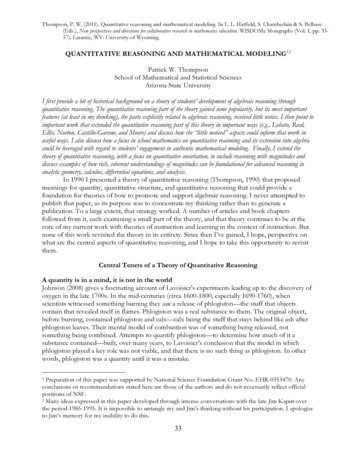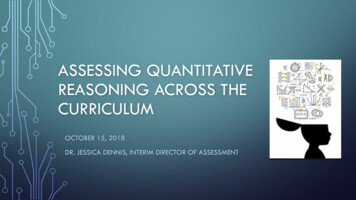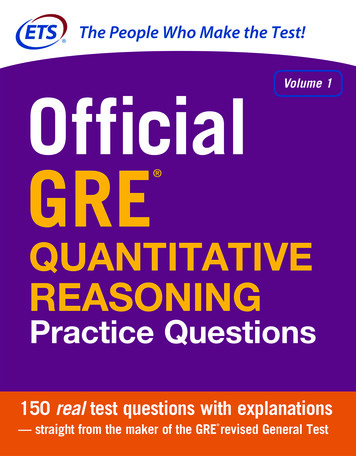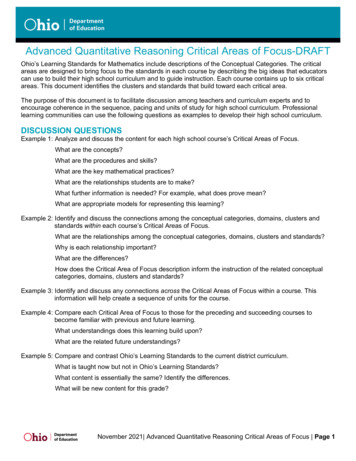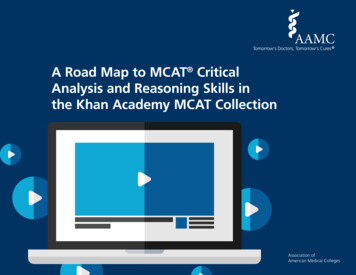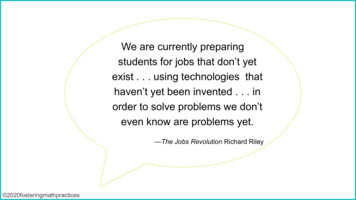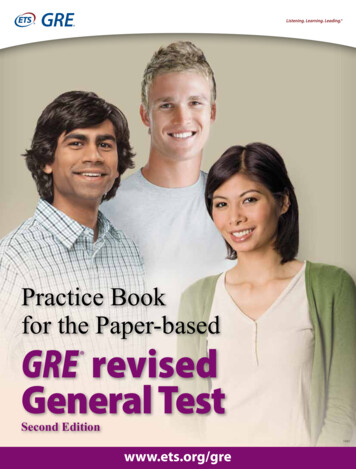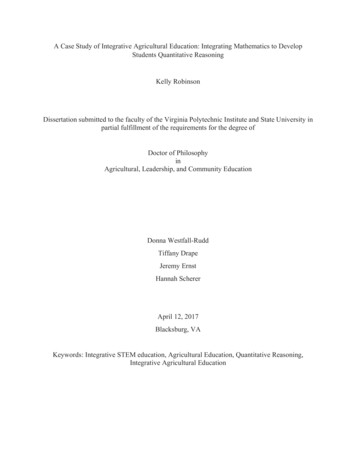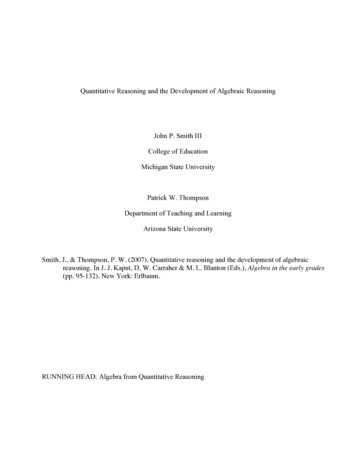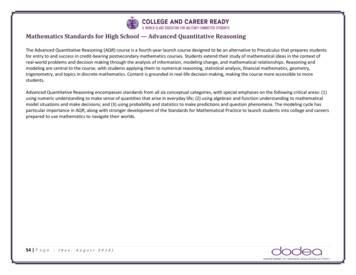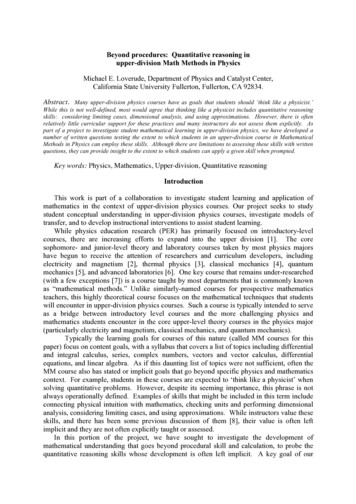
Transcription
Beyond procedures: Quantitative reasoning inupper-division Math Methods in PhysicsMichael E. Loverude, Department of Physics and Catalyst Center,California State University Fullerton, Fullerton, CA 92834.Abstract. Many upper-division physics courses have as goals that students should ‘think like a physicist.’While this is not well-defined, most would agree that thinking like a physicist includes quantitative reasoningskills: considering limiting cases, dimensional analysis, and using approximations. However, there is oftenrelatively little curricular support for these practices and many instructors do not assess them explicitly. Aspart of a project to investigate student mathematical learning in upper-division physics, we have developed anumber of written questions testing the extent to which students in an upper-division course in MathematicalMethods in Physics can employ these skills. Although there are limitations to assessing these skills with writtenquestions, they can provide insight to the extent to which students can apply a given skill when prompted.Key words: Physics, Mathematics, Upper-division, Quantitative reasoningIntroductionThis work is part of a collaboration to investigate student learning and application ofmathematics in the context of upper-division physics courses. Our project seeks to studystudent conceptual understanding in upper-division physics courses, investigate models oftransfer, and to develop instructional interventions to assist student learning.While physics education research (PER) has primarily focused on introductory-levelcourses, there are increasing efforts to expand into the upper division [1]. The coresophomore- and junior-level theory and laboratory courses taken by most physics majorshave begun to receive the attention of researchers and curriculum developers, includingelectricity and magnetism [2], thermal physics [3], classical mechanics [4], quantummechanics [5], and advanced laboratories [6]. One key course that remains under-researched(with a few exceptions [7]) is a course taught by most departments that is commonly knownas “mathematical methods.” Unlike similarly-named courses for prospective mathematicsteachers, this highly theoretical course focuses on the mathematical techniques that studentswill encounter in upper-division physics courses. Such a course is typically intended to serveas a bridge between introductory level courses and the more challenging physics andmathematics students encounter in the core upper-level theory courses in the physics major(particularly electricity and magnetism, classical mechanics, and quantum mechanics).Typically the learning goals for courses of this nature (called MM courses for thispaper) focus on content goals, with a syllabus that covers a list of topics including differentialand integral calculus, series, complex numbers, vectors and vector calculus, differentialequations, and linear algebra. As if this daunting list of topics were not sufficient, often theMM course also has stated or implicit goals that go beyond specific physics and mathematicscontext. For example, students in these courses are expected to ‘think like a physicist’ whensolving quantitative problems. However, despite its seeming importance, this phrase is notalways operationally defined. Examples of skills that might be included in this term includeconnecting physical intuition with mathematics, checking units and performing dimensionalanalysis, considering limiting cases, and using approximations. While instructors value theseskills, and there has been some previous discussion of them [8], their value is often leftimplicit and they are not often explicitly taught or assessed.In this portion of the project, we have sought to investigate the development ofmathematical understanding that goes beyond procedural skill and calculation, to probe thequantitative reasoning skills whose development is often left implicit. A key goal of our
larger project is to develop a series of tasks that would be suitable for use by instructors in theMM course. For this report, we describe preliminary efforts to develop written tasks that askstudents to apply such skills and to document student responses to them. For the purpose ofthis paper, we will refer to questions designed to assess several quantitative reasoning skills.The set of these skills is not intended to be complete, but we have identified several thatappear to be relevant as starting points: Using dimensional / unit analysis Testing expressions with limiting cases Using approximations, e.g., with Taylor series Identifying errors in solutions Predicting the effects of problem changes on the resulting solutionDuring the current study we have examined several of these skills. Examples of usingapproximations and of predicting the effects of changes to a problem on the resulting solutionhave been described previously [9, 10]. For this short paper we restrict the discussion to thesecond: limiting cases.This work has taken place in the context of a MM course taught at a large publiccomprehensive university serving a diverse student population. The course is required forphysics majors and is a prerequisite for upper-division theory courses; for most students it isone of the first upper-division courses taken. The course uses the text by Boas [11] andcovers a fairly standard list of topics. It meets for two 75-minute blocks per week. Thecourse has as prerequisites three semesters of calculus, and most students have completed atleast two semesters of introductory physics. The author has taught the course six times, withenrollments between 12 and 19. Data shown is from written responses to the Evaluate theExpressions task shown below.Theoretical PerspectiveThis portion of our project is driven by practice; we are seeking to learn what isdifficult for students and develop instructional interventions. The theoretical frameworkguiding our analysis for this portion is “identifying student difficulties” [12].A growing body of work in PER has examined student use of mathematics in physics.In particular, several models have been proposed to describe student use of mathematics. Ineach of these models, successfully executing the mathematical procedure in question is onlyone element of success. Redish has proposed a framework to describe student usage ofmathematics in science course [13], describing stages of modeling, processing, interpreting,and evaluating. For the specific case of upper-division physics courses, Wilcox et al. haveproposed the ACER framework ‘to guide and structure investigations of students’ difficultieswith the sophisticated mathematical tools used in their physics classes.’ [14] In thisframework, students must activate the appropriate mathematical tool in addition toconstructing a model, executing the mathematics, and then reflecting on results.In traditional physics courses, instruction and assessment tend to focus disproportionatelyon what Redish describes as the processing phase, or what the ACER framework frames asexecuting mathematics. In a recent paper, Redish states that ‘our traditional way of thinkingabout using math in physics classes may not give enough emphasis to the critical elements ofmodeling, interpreting, and evaluating’ [12]. The tasks in this study reflect our attempt toinvestigate other aspects of mathematical thinking. For example, to probe reflection orevaluation of results, students might be asked to evaluate expressions for correctness oridentify errors in solution, rather than performing procedures to generate expressions.We have examined the RUME literature for corresponding studies but there appears to berelatively little focus on these sorts of skills, at least at this level of instruction. The work bySherin describing how physics students read mathematical expressions bears upon the task
described below [xx]. Thompson has examined ‘quantitative reasoning’ and its relationshipto modeling of phenomena [1x5]. In addition, this project as a whole considers transferbroadly, as we examine how students apply their mathematical knowledge in the context ofphysics courses, and we have been guided in part by the work of collaborator Wagner [1x].It is important to note there are limitations of the current study, which artificiallyseparates these tasks from a problem solution. Qualitative studies of students in the process ofsolving problems can help to give insights into when and how students activate suchresources and at what phase of problem solving they are employed. This project has a moremodest goal, asking whether students can apply skills when their use is explicitly cued.Additional qualitative work, including interviews, is ongoing.MethodologyFor the purpose of this paper, we will focus on a sample task that is illustrative of thequantitative reasoning skills that we are describing. This task, which we refer to as theEvaluate the Expressions task, involves the evaluation of mathematical expressions forcorrectness. The problem is posed on the first day of the MM course on an ungraded quizsubsequently explored in a large group discussion while the tasks projected on a screen.Consider the motion of two blocks connected to form an Atwood’smachine. The masses of the two blocks are m1 and m2 and the mass of thepulley is M. The following expressions are proposed for the acceleration ofblock 1. For each, evaluate whether the expression could be correct anexplain briefly:! !!𝑎 !! !!! 𝑔!!𝑎 !!!! !!! !!!𝑔𝑎 !! ! !! !! 𝑔! !!! !!FIGURE 1. A written task in which students are asked to evaluate multiple expressions forpossible correctness given a physical situation.The task describes a simple physical system (known in physics as an ‘Atwood’smachine’) in which two massive blocks are connected by a string across a pulley (see Figure1). Students are shown three expressions for the acceleration of one of the two blocks andasked to determine whether the expressions could be correct. (All three expressions areincorrect.) The Atwood’s machine is a common instructional task and widely used in physicscourses as an example of the application of Newton’s laws. Most students would have solveda similar problem in their introductory mechanics course, encountering the problem first inthe case of a massless pulley, solving the problem by drawing free body diagrams for the twoblocks and applying Newton’s second law with appropriate constraints to generate equationsof motion. Later, in the section of the course focusing on rotational dynamics, the effect oftorques on the pulley mass are treated explicitly.The problem is different from many tasks that students have encountered to this point inthat it asks for evaluation (per Redish) or reflection (per Wilcox) rather than a proceduralcomputation. Students are not asked to solve the problem, which has no numerical values.The expectation is that students will use quantitative reasoning to arrive at an answer, bychecking limiting cases (e.g., considering extreme values of variables; a very large pulleymass means small acceleration) or by identifying cases in which the expression becomesunphysical (e.g., in the second expression, if M/2 m1 m2 acceleration would be infinite).
The problem has been administered in three sections of MM (N 47) before anyinstruction. Student written responses were examined and coded. Answers were coded foranswer and explanation. Student responses are tentatively assigned to categories that ariseiteratively according to the major themes identified in the data. For the explanations, we useopen coding (drawn from grounded theory), in which the entire data corpus is examined forcommon trends, and all data are reexamined and grouped into the defined categories.ResultsStudent responses were coded iteratively based on both the correctness of theirassessment and the explanation used in support. In the final version of the rubric, twelvedistinct but not exclusive codes were used, with an ‘other/blank’ category used when studentsprovided no intelligible explanation. Of the twelve codes, only a few were commonly used.We provide brief examples of several of the most common codes and criteria in Table I.While some of the codes that emerged were expected, many of them were not. Forexample, a few students evaluated the correctness based on whether the resulting expressionwould have the correct algebraic sign, although no coordinate axis is specified. Of course thewritten explanation may not indicate fully the underlying reasoning that students are using.For example, a few students gave explanations in which they stated that the rotational inertiaof the massive pulley mass would decrease the acceleration. Others simply noted thepresence or absence of the pulley mass in the expression. We cannot be sure whether thestudents in two groups were using similar reasoning.TABLE 1. Sample codes for evaluate the expression task. The codes were not exclusive,so a student response might include both mechanism and mass difference, for example.CodeDescriptionSolutionAttempted to solve problem directlyVariablesNoted presence or absence of variables in expressionMechanismDescribed physical mechanism for motion (forces, energy)Commented on presence or absence of term describingMass differencedifference in masses (m2-m1)The data indicate that this task is challenging task for students. Only one student offereda completely correct solution. Ten others identified all three solutions as incorrect but withincomplete or incorrect explanations. Many students gave no response. About 10% ofstudents were coded as ‘blank’ for the first expression, and 20% for the second. Writtenexplanations often indicated a lack of confidence in responses: “This is not correct becausethe mass of the pulley needs to be incorporated (although to tell the truth I am not sure how).”The approaches used by students varied considerably, and while many did giveexplanations that call upon physical intuition or an attempt to parse the mathematicalexpression, others seemed to respond as though this task were a more typical end-of-chapterproblem. About 10% of the students solved the problem directly, and a few others performedalgebraic manipulations of the given expressions. A few responses appeared as though theywere to a multiple-choice question, with a circle or check mark next to one expression. Onestudent wrote that the first response “Needs the pulley!” and circled the second response,writing “This one!!!” A few students mentioned partially remembered results: “my veryrusty memory only recalls subtracting from the bottom.” These responses suggest anepistemological stance that is quite different that the problem intends, and students may needto have the purpose of this activity framed very explicitly.Limiting cases: Only a handful of students explained using quantitative reasoning fromthe categories described above to evaluate this expression. As an example of a response that
we coded as using limiting cases, one student wrote, “No, if m2 0 kg then this formulamakes a 0 m/s2 which is clearly not true.”Presence / absence of variables: A very common code reflected responses in whichexplanations referred to the presence or absence of variables: “This could be correct becauseall relevant variables are used.” For the first expression, most students gave explanations thatreferred to the absence of the mass of the pulley. A few ( 5%) stated that the expression wasincorrect because of the absence of the pulley mass M, but the more common response was tostate (correctly) that the expression would be correct if the mass of the pulley is negligible.Physical mechanism: Several student responses described a physical mechanism for themotion. A smaller group reflected an attempt to reconcile the mathematical form of theexpression with this sense of physical mechanism. The most obvious examples of this werestudents who referred explicitly to the presence or absence of a term with the difference inmasses. These responses included some in which the presence of this term was noted:“Correct [first expression]; m2 is countering m1 so m1 is accelerating at a portion of g.” Afew students gave explanations that reflected similar reasoning but with respect to otherquantities: “this [second] expression raises the value of acceleration as the mass of the pulleyincreases leading me to believe this is incorrect.”DiscussionThis portion of the project is in initial stages, and further research is needed. Interviewsfocusing on these skills are in progress, including the Evaluate the Expressions task. Weoffer two tentative observations.First, many students entering the MM course do not successfully reason quantitativelyeven when explicitly prompted to do so. The responses given by some students suggest thatthey do not recognize that the tasks shown require them to step away from solving theproblem directly or remembering its answer in order to reason whether a solution might becorrect. Relatively few students spontaneously examined the expressions for special cases ofthe variables in the problem or related to a sense of physical mechanism. Traditionalinstruction, focused almost entirely on procedures, does not necessarily lead students todevelop other quantitative reasoning skills.Second, given that physicists value the quantitative skills described, that there is a needfor tasks that can be used in instruction and assessment. Redish and Kuo [12] have recentlywritten that students “need to learn a component of physics expertise not present in mathclass—tying those formal mathematical tools to physical meaning .We as physicsinstructors must explicitly foster these components of expert physics practice to help studentssucceed in using math in physics.” Yet the majority of problems in the course text are merelymathematical exercises that do not explicitly address these reasoning skills.Questions for audienceIs there existing theoretical or empirical work in RUME that would complement orinform this study?PER-influenced physics instruction has led to increased emphasis on conceptualunderstanding and sense-making rather than procedural tasks and routine computations. Weclearly have a lot to learn from the RUME community regarding the ways that students thinkabout mathematical sense-making; what have we overlooked due to our disciplinary filters?What are the implications for research and practice in mathematics education?
References[1] M. E. Loverude and B. S. Ambrose, “Editorial: Focused Collection: PER in UpperDivision Physics Courses,” Physical Review Special Topics in Physics EducationResearch 11, 020002 (2015).[2] See, e.g., R. E. Pepper, S. V. Chasteen, S. J. Pollock, and K. K. Perkins, “Observationson student difficulties with mathematics in upper-division electricity and magnetism,”Physical Review Special Topics Physics Education Research 8, 010111 (2012).[3] See, e.g., B.S. Ambrose, “Investigating student understanding in intermediatemechanics: Identifying the need for a tutorial approach to instruction,” American Journalof Physics, 72(4), 453-459 (2004).[4] See, e.g., T. I. Smith, J. R. Thompson and D. B. Mountcastle, “Student Understanding ofTaylor Series Expansions in Statistical Mechanics,” Physical Review Special Topics Physics Education Research 9, 020110 (2013).[5] See, e.g., S. B. McKagan, K. K. Perkins, and C. E. Wieman, "A deeper look at studentlearning of quantum mechanics: the case of tunneling." Physical Review Special Topics– Physics Education Research 4, 020103 (2008).[6] B. M. Zwickl, T. Hirokawa, N. Finkelstein, and H. J. Lewandowski, “Epistemology andexpectations survey about experimental physics: Development and initial results,”Physical Review Special Topics – Physics Education Research 10, 010120 (2014)[7] For an example of studies in a combined mathematical methods / classical mechanicscourse, see SEI: Science Education Initiative at University of Colorado ysics.htm[8] E. F. Redish, “Problem solving and the use of math in physics courses.” In ConferenceWorld View on Physics Education in 2005, Delhi, August 21–26, 2005.[9] M.E. Loverude, “Assessment to complement research-based instruction in upper-levelphysics courses, 2011 PERC Proceedings [Omaha, NE, August 3-4, 2011], edited by N.S. Rebello, P. V. Engelhardt, and C. Singh [AIP Conf. Proc. 1413, 51-54 (2012).[10] M. E. Loverude, “Surprisingly, there is an actual physical application,” Studentunderstanding in Math Methods, 2013 PERC Proceedings [Portland, OR, July 17-18,2013], edited by P. V. Engelhardt, A. D. Churukian, and D. L. Jones.[11] M. Boas, Mathematical Methods in the Physical Sciences, Wiley (2006).[12] P. R. L. Heron, “Empirical investigations of learning and teaching, Part I: examining andinterpreting student thinking,” Proceedings of Enrico Fermi Summer School on PhysicsEducation Research. (pp. 341-350). Italian Physical Society (2003).[13] E. Redish & E. Kuo, “Language of physics, language of math: disciplinary culture anddynamic epistemology,” Science and Education 24, 561-590 (2015).[14] B Wilcox et al, “Analytic framework for students’ use of mathematics in upper divisionphysics,” Physical Review Special Topics – Physics Education Research 9, 0201191(2013).[15] B. L. Sherin, “How students understand physics equations,” Cognition and Instruction19, 479–541 (2001).[16] P. W. Thompson, “Quantitative reasoning and mathematical modeling,” in L. L.Hatfield, S. Chamberlain & S. Belbase (Eds.), New perspectives and directions forcollaborative research in mathematics education. WISDOMe Mongraphs (Vol. 1, pp.33- 57). Laramie, WY: University of Wyoming.[17] J. F. Wagner, “Transfer in pieces,” Cognition and Instruction 24, 1–71 (2006).
quantitative reasoning skills that we are describing. This task, which we refer to as the Evaluate the Expressions task, involves the evaluation of mathematical expressions for correctness. The problem is po
